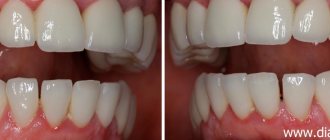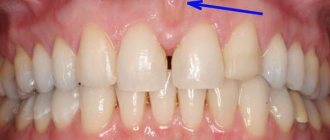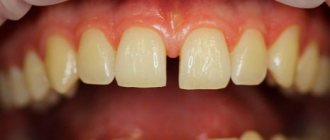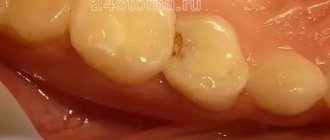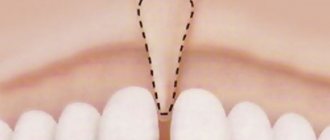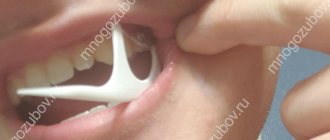Indications and methods for artistic dental restoration
Artistic restoration of teeth
This is a method in which the natural structure of the tooth is restored by copying dental tissues with various materials. Restoration can be carried out to change the position of teeth, to change their color and to eliminate existing defects.
Video example of restoration of anterior teeth (incisors) with composite material (eng)
Video of restoration of the upper canine with composite material (eng)
Dental restoration is a treatment whose indications are the presence of caries, any non-carious lesion of the tooth (fluorosis, enamel erosion, abrasion of the surface of the teeth, etc.), chips and cracks, gaps between teeth, enamel pigmentation, as well as incorrect positioning of teeth in dentition. At the moment, there are direct and indirect methods of dental restoration. Which method will be used depends on the problem that needs to be fixed and your wishes.
Direct dental restoration
It is performed directly in the dentist’s chair using special restoration materials. The convenience of this method lies in the fact that in one visit to the doctor you can solve your problem and enjoy a beautiful smile. However, there are cases when indirect dental restoration may be necessary; the prices for dental services in this case will be significantly higher than for direct restoration. This restoration method involves the production of thin porcelain or composite plates - veneers.
Indirect dental restoration
Now it is accepted as very high quality, since it requires making the most accurate shape of the material for your tooth in the laboratory. Due to this, such similarity with natural dental tissues is achieved.
Dental restoration techniques are used differently depending on the chosen restoration method. They differ in that with the indirect method, this technique takes place in several stages. With the indirect method, two visits to the doctor are required, taking an impression, installing a temporary filling, fitting, and only then installing the restoration material.
Our specialists will select the most suitable restoration method for your specific case and answer all questions that may arise. Teeth restoration before and after photos will show you what effect our doctors achieve.
Dental restoration: prices in clinics
For dental restoration, the price in different dental clinics will vary greatly, but truly high-quality aesthetic work in this case definitely cannot be cheap. To obtain a close to ideal aesthetic result, you need an experienced dentist with certain skills, training for which costs a lot of money, more expensive filling materials are also required, as well as a significant investment of time. All this increases the cost of the service.
When choosing a doctor, it is not enough to rely on reviews - ask to see before and after photos (of real patients treated in the clinic). It’s usually not worth relying on photographs on clinic websites, because... Most dental clinic websites do not post their own work, but pictures copied from the Internet. Below we will calculate the cost of dental restoration in a mid-price clinic (prices in premium segment clinics can be 2 or more times more expensive).
1) Complete restoration of the tooth crown –
In photos 7-9 you can see a real case of artistic restoration of the front teeth, performed with the crown part completely missing. When restoring tooth crowns, fiberglass pins and a composite light-curing filling material were used. For such dental restoration the cost will be no less than 6,000 rubles per tooth.
Restoration of anterior teeth: before and after photos
The cost of a complete tooth restoration consists of the following items.
- Anesthesia – from 400 rub.
- Applying a rubber dam to isolate a tooth from saliva – from 700 rubles.
- Sterile kit – from 150 rub. this includes: a mask and gloves for the doctor, shoe covers and a bib for the patient, the cost of sterilizing the instrument.
- Restoring a crown from a light composite costs about 3,500-5,000 rubles.
- Fixation of a WDW fiberglass pin in the channel – RUB 1,500.
this is a very important stage (Fig. 8)! The pin is necessary to prevent premature breakage of the restored tooth crown due to the fact that it will experience significant mechanical stress when chewing and biting off food. For the restoration of front teeth, it is very important that the pin is fiberglass and not metal - otherwise the metal will show through the filling material and the crown of the tooth will be bluish in color. Of course, you can install cheaper pins, for example: a) a metal pin (cost 50 rubles), but in this case, the restored tooth will not have the same transparency and natural shade “like natural teeth.” Although for teeth that are not included in the smile line, this is not so scary. b) Russian-made fiberglass pin (cost 50 rubles), but such pins also do not have proper light conductivity, and in addition have insufficient adhesion (stickiness) to filling materials. This leads to their poor fixation in the root canals and the risk of the “extended” tooth falling out along with such a pin. Total: the cost of tooth restoration is from 5,000 to 7,000 rubles.
2) Restoration of half a tooth –
If a full crown restoration (using a fiberglass pin) costs 5-7 thousand rubles, then restoring half a tooth crown without a fiberglass pin, but taking into account all other costs, will cost approximately 1500-2000 rubles less. Total: from 3500 to 4000 rubles.
3) Restoring a chipped cutting edge of a front tooth –
Restoring the angle of a tooth crown using a light-polymer filling material will cost from 1,500 to 3,000 rubles (depending on the amount of work/size of the chip).
What materials are used for dental restoration?
Dental restoration is the restoration of a chipped, broken or partially destroyed tooth by caries or in some other way. The materials used for dental restoration depend on which method was chosen. For direct restoration, the dentist uses composite materials (photopolymers); indirect restoration is longer and more expensive, because this method requires time to make a veneer from ceramic mass.
Dental restoration with composite materials has many adherents around the world. The development of aesthetic dentistry allows the use of the latest restoration materials, which helps patients not be embarrassed about their smile after just a couple of visits to the doctor. Photopolymers, which have found their application in the restoration process, are very convenient to work with, because they very easily take the desired shape. Composite dental restoration allows you to change the color of a tooth, restore and change its shape, and close the gaps between teeth.
Prices for dental restoration using photopolymer composite will depend mainly on the degree of damage to the tooth, the chosen treatment method and the composite material used. Dental restoration using filling material is in many ways inferior to restoration using veneers. Over time, this material may darken, lose its shine, and if the tooth is severely damaged, such a restoration can be destroyed under the influence of external factors.
Types and degrees of curvature
The method of restoring crooked teeth depends on the degree of curvature and the age of the patient. On the Internet you can find many photos of celebrities with crooked teeth before and after restoration. How does the correction process work?
First, let's look at the degrees of curvature:
- First degree: refers to individual teeth that differ from the rest in shape, size or location.
- Crooked teeth 2 degrees: incorrectly formed dentition due to the simultaneous eruption of several teeth at once.
- Third degree: curvature at the level of the jaws, which leads to improper closure of the upper and lower dentition.
In addition, the front teeth, incisors or wisdom teeth may be crooked. The front ones, as a rule, change shape or location due to external factors: injuries, the habit of chewing a pen or seeds.
Orthodontist Anastasia Sergeevna Arkhangelskaya from the 32 Dent clinic explains why teeth grow crooked in adults: “In adulthood, people often have to have their teeth removed. If an implant or other prosthesis is not installed in their place, the dentition may become crooked. In addition, the development of dental anomalies is facilitated by the eruption of wisdom teeth. This is especially true for people with a narrow jaw, which simply does not have enough space for large wisdom teeth.”
If you have a problem similar to that described in this article, be sure to contact our specialists. Don't diagnose yourself!
Why you should call us now:
- We will answer all your questions in 3 minutes
- Free consultation
- The average work experience of doctors is 12 years
- Convenient location of clinics
Single contact phone number: +7
Make an appointment
Sequence of the dental restoration process
There is a certain sequence in which the restoration procedure is carried out. This methodology must not be violated, otherwise you will not get the desired result. So, the stages of dental restoration:
- Preparation for the restoration procedure. The tooth surface is mechanically cleaned, anesthesia is applied if necessary, and the tooth is isolated from saliva using a rubber dam.
- Tooth preparation. Removing pigmented enamel, softened dentin and cleaning teeth from caries.
- Gasket application. It is necessary to protect the pulp from possible exposure to the composite.
- Etching dentin and enamel. It is necessary for the sterility of the surface of the cavity and promotes better adhesion of the hard tissues of the tooth to the composite.
- Applying primer to the surfaces of enamel and dentin. Makes dentin airtight, thereby limiting it from any external influences due to clogging of dentinal tubules.
- Application of composite and its plastic modeling.
- Composite polymerization. Hardening of the composite material.
- Final processing of the restoration. The surface is modeled and formed after restoration.
- Carrying out control tests and correction of restoration work.
- Surface polishing.
- Final polymerization.
What are veneers for crooked teeth?
Microprostheses are thin plates-onlays installed on the front surface of the tooth. Such restoration allows you to effectively mask the defects of visible teeth without large-scale destructive manipulations. Thin petals are placed on the incisors or fangs, covering the cutting edge. Currently, two types of starting materials are used:
- Ceramics are more expensive
, but more aesthetically pleasing and visually indistinguishable from natural teeth. The pressed massif is quite durable and does not stain when using colored foods. - The composite changes color
and cannot be bleached. To maintain the presentability of such veneers, you will have to adhere to strict dietary restrictions.
Mini-plates are attached to the outside of the teeth, fixed with a special compound, activating it using the light of a special lamp.
Alternative restoration
Restoration of the tooth crown
Can be produced in various ways. Our clinic offers them all. This can be traditional dental filling, covering the tooth surface with veneers, restoring the anatomical shape of the tooth using a crown, or any existing method of prosthetics (implants, inlays, etc.). The main task of the dentist is to choose and offer the patient the most optimal method of tooth restoration.
Dental restoration with veneers
This method will be acceptable in the following cases:
- treatment of chipped teeth;
- getting rid of a small gap between the front teeth;
- changes in enamel color that cannot be bleached in any other way;
- changes in the shape of the tooth crown;
- changes in moderate curvature of teeth.
Dental restoration with inlays
It is used for minor tooth damage, when restoration of 1-2 sides is necessary. There are restorative (restore the shape and color of the tooth) and stump (a crown is then placed on top of them) inlays. Inlays can be made of metal, ceramics, metal-ceramics, as well as composite and all-ceramic.
If your tooth is more than half destroyed, and even more so if the nerve in it has also been removed, then it is recommended to install a crown. They are ceramic and metal-ceramic. Service life, aesthetics and reliability are superior to conventional restoration methods.
Indications and contraindications
If extension is the restoration of the dentition (regardless of the location of the teeth), then the same procedure, but only with the front teeth, is restoration (although many do not see much of a difference between these concepts). With the help of restoration, you can not only eliminate the defect that has arisen, but also give the tooth maximum naturalness so that it does not stand out from others.
Dental restoration
Indications for extensions look something like this:
- the appearance of interdental gaps;
- development of caries, due to which part of the tooth was lost;
- age-related wear of incisors;
- discoloration of tooth enamel, if no cleaning or whitening procedures help correct the situation;
- crooked teeth;
- malocclusion;
- mechanical damage resulting in bone tissue damage;
- formation of cracks on the tooth surface;
- appearance of a chip.
On a note! The extension procedure, or rather its appearance, is a serious step in the development of modern dentistry. It (the procedure) allows you to eliminate existing problems of an aesthetic nature with the restoration of teeth.
Dental restoration - before and after
Main contraindications to extensions:
- patient's health problems and poor health. In this case, it is not recommended to carry out restoration - you first need to cure the body, and only after that can the procedure be carried out;
- the presence of caries or other cause of the defect. Before extensions, it is imperative to eliminate the main cause of the problem. The same applies to inflammation of the gums, in the presence of which doctors do not undertake restoration. After the problem has been completely eliminated, you can begin building up;
- When treating children, certain methods of tooth extension cannot be used - for example, using pins. Therefore, if the doctor said that he will install a pin for your child, it is better to contact another specialist;
Tooth on pin
- presence of bruxism (teeth grinding). The procedure can be carried out only after getting rid of bruxism. Otherwise, the likelihood of the defect reoccurring increases. Fortunately, there are many methods to eliminate this unpleasant habit, including special exercises and protective thermal splints for teeth;
- If it is impossible to protect the required area in the mouth from contact with moisture (in this case, saliva), the procedure cannot be performed for technical reasons. This is due to the fact that when in contact with moisture, the composite substance used in dentistry will not be able to dry out and completely consolidate.
Indirect restoration
To avoid unnecessary costs and problems, consultation with a doctor is necessary before performing extensions. A correct and competent approach will not only save money, but also preserve the health and nerves of the patient. If a child sits in the dentist’s chair, then his parents are simply obliged to first find out all the nuances of the upcoming operation.
Video: Service life of dental restoration
Contraindications for dental restoration procedures
- The patient has an incorrect bite.
- Absence of a certain number of chewing teeth.
- The presence of a disease - bruxism.
- Monolithic destruction of the inner enamel of the tooth.
- Unnatural tooth wear.
- Passion for dangerous sports (for example, boxing).
However, some indications can be treated, so the possibility of restoration should not be abandoned forever. You can cope with bruxism or correct a malocclusion and then contact us for dental restoration.
Why is tooth stump restoration necessary?
Tooth stump restoration is used in dentistry to restore a badly damaged tooth to a degree that allows the tooth to be prepared for installation of an artificial crown. Recently, dentists have been actively using the direct method of restoring the tooth stump (pinless method), which uses special composite materials. Very often, when a tooth is severely damaged, only the root remains and for greater support, it is necessary to install a pin (pin method). The mouth of the canal is widened, treated, filled, and only after that can a pin be installed.
There is also another way to restore a tooth stump - a cast stump inlay. This is a custom made metal post that restores the portion of the tooth above the gum. This is a monolithic alloy that has no seams or joints, which gives it greater strength and resistance to heavy loads.
Restoration of teeth using filling materials
Step 1. First, an impression of the front teeth is made, according to which the build-up with composite materials will be carried out. After this, the doctor, using special equipment, grinds the teeth down to a certain level.
Creating a cast
Grinded teeth
Step 2. Having protected the remaining teeth, the dentist treats the already ground teeth with a liquid composition, after which it hardens under the influence of ultraviolet rays.
Treatment of ground teeth with a liquid composition
Step 3. An impression is made of the teeth so that the shape of the tooth can be recreated from it. The procedure is performed extremely carefully; the doctor covers the side part of the tooth being restored with special dental onlays. During the filling process, an ultraviolet lamp is periodically used to harden the composition used.
Impression attached
Step 4. When the tooth is almost ready, its surface is treated with a protective substance that can protect the extended tooth from harmful factors (such as food, drinks, smoking, and so on).
Application of a protective composition
Step 5. As a result, the patient leaves the dentist’s office with a new snow-white smile. Moreover, this does not require much time - just one visit is enough to completely build up the front teeth.
Teeth after restoration
Artistic restoration of anterior teeth
Dental restoration in Moscow today is available to everyone, and it is especially important for that part of the teeth that we show to others. Artistic restoration of the front teeth requires good skills from the dentist not only from a medical, but also from an aesthetic point of view. This type of restoration is the most popular because people want to smile without embarrassment. Restoration of the anterior group of teeth by specialists at our clinic today is able to correct any tooth defects from chips and cracks to giving the natural color of tooth enamel.
There are direct and indirect restoration of anterior teeth. Only consultation with a specialist can help you choose one of these methods. In the first case, reflective filling materials are used. This process is based on layer-by-layer application of photopolymer material, which requires the skill and experience of a doctor. This method can be used for minor damage to the tooth, as it is subject to abrasion over time. Restoration of the frontal group of teeth, when choosing an indirect method, is based on the work of the doctor, which consists of observing several rules:
- correct selection of the color of the desired material for the veneer;
- using the correct tooth preparation technique;
- taking impressions of the front teeth;
- installation of temporary and then permanent veneer.
Restoring the front teeth with veneers will be appropriate if, after some dental procedures, it is no longer possible to achieve color by whitening. They can also be used to slightly correct the shape of your teeth. Depending on the manufacturing method and material, veneers are divided into therapeutic ones made of composite material and orthopedic ones made of ceramics. Only a qualified dentist can tell you which type you need. The effect obtained from this method of restoration can be seen in the photo before and after restoring teeth with veneers.
Few people think about the fact that when we talk or laugh, the lower part of the teeth is always visible. Therefore, restoration of the lower teeth is extremely important and simply necessary for a healthy and beautiful smile. Also, a very large load is placed on the lower row of chewing teeth, which contributes to the frequent formation of chips and caries. Therefore, you need to understand that artistic restoration of chewing teeth is important not only from a practical, but also from an aesthetic point of view.
Aesthetic restoration of the front teeth from below and above is necessary, first of all, for people who have problems with their teeth, but want to be self-confident and not be afraid of communicating with other people.
Extension - what is it?
A dental procedure that restores tooth enamel and the tooth itself. This term also includes artistic restoration of the dentition. What does this name mean? The fact is that when building up the front teeth, the dentist’s main task is not only to properly restore the tooth, but also to give it a natural appearance.
At the dentist
High-quality artistic restoration of a tooth requires a true master of his craft, with the skills of a sculptor and excellent artistic taste. All this comes with time when doctors gain experience in practice.
Restoration of the chewing group of teeth
The main goal pursued during the restoration of lateral teeth is the restoration of their functionality, that is, the restoration of chewing function. Restoration of lateral crooked teeth is necessary for several reasons.
Firstly, excessive curvature of the teeth can tear the gums, thereby causing discomfort and pain when eating.
Secondly, an incorrect bite can lead to incorrect redistribution of the load on the teeth.
Third, wide and flat surfaces will cause severe tooth wear and reduce chewing efficiency.
All these factors can negatively affect the general condition of all teeth. Therefore, during restoration, reproduction of the individual characteristics of the tooth, including macrorelief, all tubercles and pits, plays a very important role. You should monitor the health of all teeth without exception, not paying attention only to those that are visible when you smile.
Restoration of baby teeth in children
Today, even a child can have a tooth restored in our clinic. Restoration of a baby tooth is necessary in case of injury or extensive carious destruction. This method allows you to completely restore the anatomy of the crown of a baby tooth, which will allow you to preserve it until it is naturally removed and replaced with a permanent tooth. Do you think saving a baby tooth makes no sense?
You are wrong, because the health and well-being of baby teeth has a direct impact on the condition of permanent teeth. Plus, a baby tooth that falls out unnaturally can cause deformation of the dentition. After all, if the permanent tooth has not pushed it out, but the gums are empty and the neighboring teeth may begin to move. In addition, premature tooth loss can lead to deterioration of diction, changes in bite, increased load on neighboring teeth, which can also fall out prematurely and many other negative consequences. Thus, we come to the conclusion that the need for restoration of temporary teeth should not be ignored by parents. Timely intervention by a dentist in the problem will help avoid complications in the future.
Aesthetics in dentistry
In our society, a beautiful snow-white smile has already become not just a sign of health and well-being, it is good manners. That is why cosmetic dental restoration in Moscow is now so popular. Now it is customary to sparkle with the whiteness of your perfectly straight teeth and even decorate them with precious stones.
Aesthetic dental restoration involves giving the ideal appearance of the tooth, its color, shape and structure. In the hands of a professional dentist, restorative materials transform teeth into works of art. Since modern aesthetic restoration implies the complete elimination of any changes and defects on the surface of the tooth. This is exactly the kind of modern dental restoration on Vernadsky Avenue (Yugo-Zapadnaya metro station) that is available to everyone. Our clinic’s specialists will advise you and tell you what types and how restoration of tooth color, enamel and shape occurs. They will advise you on prices and explain what results you should expect from each specific restoration method.
In order to achieve a beautiful shape and durable dental covering, our dentistry uses high-quality composite materials. These materials come in a huge variety of colors to give the teeth a natural appearance and similarity to the patient's other teeth. Restoring the shape of teeth allows them to return their functionality, as well as make the size of the teeth more suitable to each other from an aesthetic point of view.
Aesthetic restoration of anterior teeth is designed to give a natural shape to the tooth line. It is known that teeth darken with age, and teeth with a removed nerve also have this unpleasant property. The color of enamel is negatively affected by eating foods that have coloring properties, as well as smoking. In modern dentistry, there are many teeth whitening systems. Restoration of tooth enamel can be carried out using any of them or by applying special lumineers and veneers.
You can contact our clinic and get all the information you are interested in about how artistic dental restoration works. Our prices are quite reasonable, and the quality of the services provided makes you come back to us again and again.
Aesthetic dental restoration video shows how the procedure takes place in the clinic.
The best material for teeth is ceramics
Ceramics have been used in dentistry for many years and are very successful. Dental restoration with ceramics is the best way to achieve an invisible and high-quality result. Dental restoration of teeth requires not only the correction of teeth from an aesthetic point of view, but also the elimination of more serious defects. Crowns, veneers, lumineers, bridges, etc. are made from this material.
Lumineers are made from high-strength pressed ceramic. They are resistant to mechanical damage, look very natural and are durable. This is an ideal replacement for regular teeth whitening.
Ceramics also have another very important quality - a wide range of colors. Choosing the right color is not difficult, since the choice is large, you can find all natural shades of teeth.
Now you have access to high-quality ceramic dental restoration at Yugo-Zapadnaya. To do this, you must come to us, here you will be pleased not only with the quality of the services provided and the professionalism of the staff, but also with the cost. Tooth restoration in Moscow at the ARTOX clinic is fast, high-quality and inexpensive .
Our specialists know first-hand what dental restoration is. You can find reviews about all restoration methods on the Internet, but you should not completely trust them. Only professional diagnostics and consultation with a doctor, a specialist in this field of dentistry, can provide you with a complete picture of the treatment and tell you how justified a particular restoration method is. The main thing is to be sure who you trust with your health.
And don't forget that regular visits to the dentist and good oral hygiene will help you prevent many dental problems. Well, if they do arise, then you must immediately seek qualified medical help in order to avoid complications. Our clinic is always ready to come to your rescue and provide quality treatment at affordable prices.

